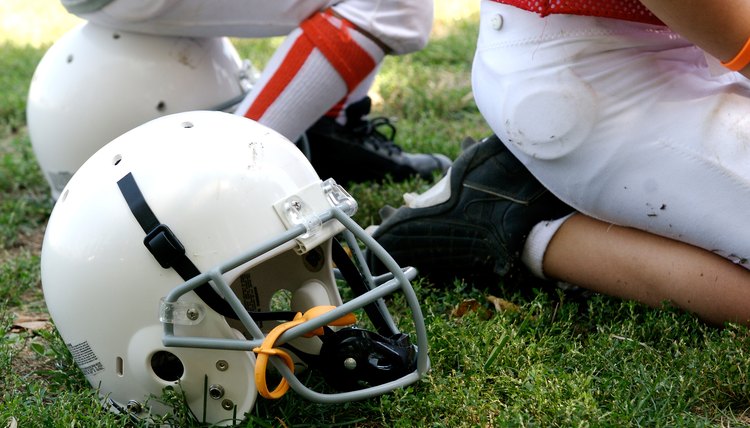Difference Between Lineman Cleats & Running Back Cleats

As amateur and professional athletes seek to improve their performance in their sports of choice, selecting the right equipment can become a challenging exercise. Gone are the days where everyone could make do with generic sneakers or basic cleats. Today's athletic equipment has become highly specialized, and football cleats are no exception. They vary in style, cleat size and component materials depending on the position and field surface for which they are designed.
Football Cleat Basics
Football cleats come in a wide range of styles and prices. Three major elements should be considered when purchasing your cleats: shoe style -- low-cut, mid-rise and high-top; type of cleats -- molded or detachable; and the materials from which the shoe is made -- leather or synthetic material are the standard choices. These selections typically are determined based on the athlete's position and the type of football field on which he most commonly plays. For example, players needing high levels of maneuverability and speed, such as a wide receiver, safety or corner back, might choose a low-cut style made of lightweight synthetics.
Cleats for Linemen
Lineman are often large, heavier-weight football players who experience repeated, high-impact contact with their opponents. They also make frequent lateral movements during play, placing added strain on the ankles. For these athletes, a high-top football cleat is typically the best choice. This style provides better support to the ankles than lower-cut styles, protecting the lineman from the continued pummeling and sideways movements he typically experiences.
Cleats for Running Backs
Running backs generally are best served by a mid-rise cleat. They need some added ankle support, like linemen, but protecting the foot itself is also important. Stiff inserts of fiberglass or other sturdy materials keep a running back's cleat from flexing too much at the wrong points. The higher cut of the mid-rise cleat and the stronger support materials protect the back's ankles and feet in both contact and running situations while offering the better maneuverability running backs need.
Molded or Detachable Cleats?
The type of cleat is another significant factor in choosing the right footwear for both linemen and running backs. The major consideration in choosing the type of cleat -- molded or detachable -- is the type of surface on which the athlete plays football. Solid, molded cleats are generally better for those playing on artificial turf, providing them with both cushioning and traction on the harder surfaces. Detachable cleats are often best for natural grass fields, since the length of the cleat can be changed depending on the ground conditions. Shorter cleats are best on hard, dry fields and longer cleats for wet or sloppy fields, according to footwear specialists at Dick's Sporting Goods.
Other Considerations
Two other factors should be considered when selecting football cleats -- material and price. Leather is a more durable, sturdy material well-suited to either the lineman or running back position. Synthetic materials are less expensive but not as durable. Synthetic cleats also may not provide the same level of protection as leather cleats. Price is a matter of personal choice and budget, as well as the level at which the athlete plays. Your 5-year-old son playing his first flag football game in a recreational league likely can get by with a less expensive cleat than a serious high school or college athlete.
References
Writer Bio
As a national security analyst for the U.S. government, Molly Thompson wrote extensively for classified USG publications. Thompson established and runs a strategic analysis company, is a professional genealogist and participates in numerous community organizations.Thompson holds degrees from Wellesley and Georgetown in psychology, political science and international relations.
